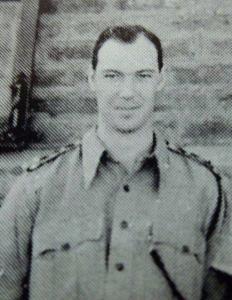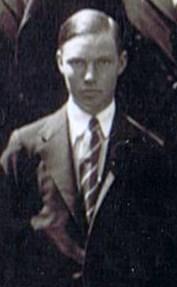
|

|
| Major Richard Hamilton GILLETT (EC/1166) | |
|
7th Battalion, 10th Baluch Regiment attached to A Company, 152nd (Indian) Battalion Parachute Regiment Date of birth: 13th February 1917 Date of death: 26th March 1944 Killed in action aged 27 Buried at Imphal War Cemetery Plot 8 Row G Grave 23 |

|
| Richard Hamilton Gillett was born at Ouseburn in Yorkshire on the 13th of February 1917 the only son of Aubrey Scott Gillett FRCS, a surgeon of Dominica British West Indies, and Margaret Elsie (nee Potts) Gillett of Clutton in Somerset. His parents divorced in 1924 and he moved with his mother to Bridge House, Lynford in Devon. He was educated at Lancing College where he was in Seconds House from January 1931 to 1935. He gained his School Certificate in 1934. He was appointed as a House Captain in 1934 and was a Corporal in the Officer Training Corps achieving Certificate A the same year. On leaving school he entered the Royal Military College Sandhurst in 1935 but it appears he did not complete his course there. Instead he became an assistant school master at Grenham House School at Margate in Kent. Following the outbreak of war, he joined the Special Constabulary before entering the 153rd Officer Cadet Training Unit of the Grenadier Guards in March 1940. On the 28th of September 1940, he was commissioned as a 2nd Lieutenant in the 7th Battalion, 10th Baluch Regiment, Indian Army. He embarked for service in India at Liverpool on board the SS “Sagaing” on the 25th of December 1940. By September 1941 he was acting in a training role for the battalion and the following month he volunteered for the newly formed Indian Parachute Brigade for which he was accepted and was promoted to Lieutenant on the 29th of October 1941. He was promoted to Temporary Captain and appointed as Company Commander of A Company in the 152nd Battalion. On the 1st of June 1942 Richard Gillett led the first operational jump by the battalion when they dropped into the Sindh Desert where they spent two months in operations against Hur tribesmen who had been attacking and looting trains in the area. He was granted a months home leave from the 21st of April 1943. On the 8th of March 1944 the Japanese began crossing the Chindwin River as a prelude to the invasion of India. The two first key objectives of their attack across the border was the capture of the British held towns of Kohima and Imphal. By mid March the 152nd (Indian) Battalion Parachute Regiment, under Lieutenant Colonel Paul Hopkinson, was at a position known as "Kidney Hill" a few miles to the east of the village of Sangshak. As reports of the forward movement of the Japanese came in from local Naga tribesmen, Hopkinson pushed two of his companies out onto the surrounding Somra Hills. A Company, under Richard Gillett, were sent to Point 7386 ("Badger") and to Point 7000 ("Gammon") and C Company, under Major John Annesley O'Donnell Fuller, were sent to the unnamed Point 7378. At dawn on the 19th of March 1944 a column of Japanese troops, estimated to be at battalion strength, were spotted moving towards Fuller's position. Although Fuller had an observation team to his front it wasn’t until 09.00 that he heard from them to the effect that the enemy were heading directly for his position. By 14.00 the Japanese had surrounded his position and they attacked an hour later. The first attack was successfully repelled but further attacks followed and during the evening Colonel Hopkinson decided to despatch Richard Gillett’s A Company to strengthen Fuller’s garrison. By first light on the 20th of March nothing more was heard from C Company and according to Japanese accounts the fighting was over by noon. By the time Gillett’s men arrived near Point 7378 the fighting was in its last stages and their efforts to reach C Company had been in vain. They returned exhausted, rejoining their battalion during the afternoon. Due to the strength of the Japanese forces ranged against him Hopkinson decided to concentrate his resources at the village of Sangshak and by the 22nd this move had been completed. As dusk fell the first of Japanese came into view and went straight into the attack but were thrown back with heavy casualties. They attacked twice more during the night but by dawn things fell quiet again. During the afternoon of the 23rd the RAF dropped supplies to the Sangshak garrison but most of the parachutes fell into enemy held territory. More bad news followed when scouts reported that the enemy were now behind the village and that the garrison was surrounded. More attacks supported by artillery followed during the night but these were again driven off with enemy casualties being heavy. During the day of the 24th ammunition began to run low and the British defenders crouched in their shallow trenches, under observation from surrounding hills and under fire from two machine guns sited there. Added to this was an increasing amount of artillery fire as the enemy guns came into position causing casualties to mount among the increasingly beleaguered defenders of the village. A dawn attack on the 25th was also forced back with heavy hand to hand fighting inflicting losses on both sides. During the afternoon of the 25th Hopkinson withdrew his men to a tighter circle in order to concentrate them for the next stage of the battle. The Japanese had seen this movement and infiltrated men into the vacated areas of the village. At 03.30 on the morning of the 26th they attacked again and twelve more hours of continuous fighting followed. Richard Gillett was killed in fighting near the church during the morning. Although much of the ground lost during the day was regained, the battle was effectively over. As darkness fell that evening the surviving defenders of the village abandoned the position and began to make their way through the Japanese encirclement and to the rear where they trickled in over the next few days to join the British forces further to the west at Imphal. The 152nd Parachute Battalion had lost some eighty per cent of its strength during the battle but had been part of a defence which had cost the invading Japanese dear. The enemy had lost heavily in terms of supplies as well as in men and the Battle of Sangshak contributed greatly to the subsequent failure of the Japanese to take Kohima and Imphal. He is commemorated on the war memorial at Lynford and on the memorial at the Royal Military College Sandhurst. |
|
 | |
| Seconds House |
Back